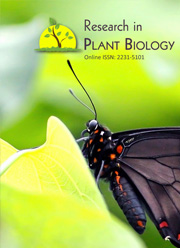Peculiarities of Growth and Metabolism in Japanese Kelp in Habitats Exposed to Chronic Contamination
Keywords:
toxic elements, Japanese kelp, cortical tissue, parenchyma, conductive tissue, sporiferous tissue, chemical compositionAbstract
A higher content of toxic metals, particularly cadmium and arsenic, was detected in Laminaria japonica (Rudnaya Bight, The East (Japan) Sea). These seaweeds were found to have anatomic alterations in the vegetative tissue, inhibition of development of the generative tissue and stronger pigmentation. It was also established that Laminaria japonica (in Rudnaya Bight) contained more monovalent metals, like potassium, and less divalent ones, calcium and magnesium, as compared to seaweeds from an ecologically clean area (Cape Mayachnyi, The East Sea). Content of iodine and fucose in seaweeds that grew in Rudnaya Bight was lower than that in seaweeds collected near Cape Mayachnyi. Changes of chemical composition in Japanese kelp from Rudnaya Bight proved to be most evident in seaweeds in the first year of their growth, and the greatest morphological and anatomical changes in vegetative and generative tissues were in the second year.Downloads
Download data is not yet available.
Published
15-02-2012
How to Cite
Aminina, N., & Shaposhnikova, T. (2012). Peculiarities of Growth and Metabolism in Japanese Kelp in Habitats Exposed to Chronic Contamination. Research in Plant Biology, 2(1). Retrieved from https://updatepublishing.com/journal/index.php/ripb/article/view/2563
Issue
Section
Articles



 .
. 